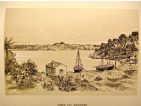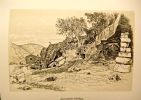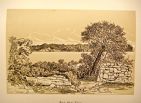“Like on Paxos, the dock is located on the eastern side, that is, the inner side, on the channel-side. The small Agriapidia port (or “port of wild pears”), cannot be used by large boats, nor does it offer much protection to smaller ones. For that reason, one has to go to Gatjas on Antipaxos after reaching the pebble-filled beach. […] After comes Spiaggia Tis Agriapidia with small houses and a pebble beach. Nearby are the Agriapidia caves.


 A walled path leads to two small houses in Stu Tita above Sto Karavi Point with an opulent bitter-orange tree in the middle. Further behind is a small copse of cypresses with thick branches. Above is the Spiro Tis Katero house with some almond trees. Further down the slope where the Holm oaks are is the lime oven. There is a delicious view of the peninsula and the following points with some groups of abundant green Holm oaks, though we sometimes find an olive tree or wild pear tree. From the tallest point there is a view of the entire island, with the copse of cypresses behind, Paxos Point, Panagia Island and the peninsula’s coastline.
A walled path leads to two small houses in Stu Tita above Sto Karavi Point with an opulent bitter-orange tree in the middle. Further behind is a small copse of cypresses with thick branches. Above is the Spiro Tis Katero house with some almond trees. Further down the slope where the Holm oaks are is the lime oven. There is a delicious view of the peninsula and the following points with some groups of abundant green Holm oaks, though we sometimes find an olive tree or wild pear tree. From the tallest point there is a view of the entire island, with the copse of cypresses behind, Paxos Point, Panagia Island and the peninsula’s coastline.
 From the top of Ovoro peak, full of pebbles and some rocks, where mastics and pear trees grow, where gulls and kestrels fly and where we find a kalivi [= small house, cabin] in ruins, there is a very pretty view of the southern coasts and the following points of Sfongaria towards the west. The most beautiful view is of a daskalja with the islands in the background. [ daskalja = a dangerous rock for boats, p. 443]”
From the top of Ovoro peak, full of pebbles and some rocks, where mastics and pear trees grow, where gulls and kestrels fly and where we find a kalivi [= small house, cabin] in ruins, there is a very pretty view of the southern coasts and the following points of Sfongaria towards the west. The most beautiful view is of a daskalja with the islands in the background. [ daskalja = a dangerous rock for boats, p. 443]”
 “In Kalamitsa above Poticchio Sarakinino we can see that near the walled-in beach is a well of bad water which dries in summer. From the beach we see sulphur oozing out on the end point after the second rock, a path climbs up passing by the Kalamitsa cliffs with a pretty panoramic view of Porticchio Sarakinko. The cliffs, crowned by some mastics and pear trees, are high, some with deep caves, and where we see plates and edges and also stalactites. The rock is calcareous marl and fine, white or yellowish gray limestone. At times it is rich in forams and a medium clay content.
“In Kalamitsa above Poticchio Sarakinino we can see that near the walled-in beach is a well of bad water which dries in summer. From the beach we see sulphur oozing out on the end point after the second rock, a path climbs up passing by the Kalamitsa cliffs with a pretty panoramic view of Porticchio Sarakinko. The cliffs, crowned by some mastics and pear trees, are high, some with deep caves, and where we see plates and edges and also stalactites. The rock is calcareous marl and fine, white or yellowish gray limestone. At times it is rich in forams and a medium clay content.



























